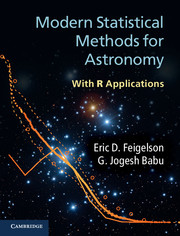Book contents
- Frontmatter
- Contents
- Preface
- 1 Introduction
- 2 Probability
- 3 Statistical inference
- 4 Probability distribution functions
- 5 Nonparametric statistics
- 6 Data smoothing: density estimation
- 7 Regression
- 8 Multivariate analysis
- 9 Clustering, classification and data mining
- 10 Nondetections: censored and truncated data
- 11 Time series analysis
- 12 Spatial point processes
- Appendix A Notation and acronyms
- Appendix B Getting started with R
- Appendix C Astronomical datasets
- References
- Subject index
- R and CRAN commands
- Plate section
12 - Spatial point processes
Published online by Cambridge University Press: 05 November 2012
- Frontmatter
- Contents
- Preface
- 1 Introduction
- 2 Probability
- 3 Statistical inference
- 4 Probability distribution functions
- 5 Nonparametric statistics
- 6 Data smoothing: density estimation
- 7 Regression
- 8 Multivariate analysis
- 9 Clustering, classification and data mining
- 10 Nondetections: censored and truncated data
- 11 Time series analysis
- 12 Spatial point processes
- Appendix A Notation and acronyms
- Appendix B Getting started with R
- Appendix C Astronomical datasets
- References
- Subject index
- R and CRAN commands
- Plate section
Summary
The astronomical context
Spatial data consists of data points in p dimensions, usually p = 2 or 3 dimensions, which can be interpreted as spatial variables. The variables might give locations in astronomical units or megaparsecs, location in right ascension and declination, or pixel locations on an image. Sometimes nonspatial variables are treated as spatial analogs; for example, stellar distance moduli based on photometry or galaxy redshifts based on spectra are common proxies for radial distances that are merged with sky locations to give approximate threedimensional locations.
The methods of spatial point processes are not restricted to spatial variables. They can be applied to any distribution of astronomical data in low dimensions: the orbital distributions of asteroids in the Kuiper Belt; mass segregation in stellar clusters; velocity distributions across a triaxial galaxy or within a turbulent giant molecular cloud; elemental abundance variations across the disk of a spiral galaxy; plasma temperatures within a supernova remnant; gravitational potential variations measured from embedded plasma or lensing distortions of background galaxy shapes; and so forth.
The most intensive study of spatial point processes in astronomy has involved the distribution of galaxies in the two-dimensional sky and in three-dimensional space. One approach, pioneered by Abell (1958), is to locate individual concentrations or “clusters” of galaxies. The principal difficulty is the overlapping of foreground and background galaxies on a cluster, diluting its prominence in two-dimensional projections. The greatest progress is made when spectroscopic redshifts are obtained that, due to Hubble's law of universal expansion, allows the third dimension of galaxy distances to be estimated with reasonable accuracy.
- Type
- Chapter
- Information
- Modern Statistical Methods for AstronomyWith R Applications, pp. 337 - 378Publisher: Cambridge University PressPrint publication year: 2012



